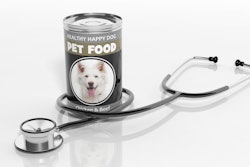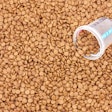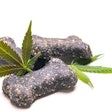
The U.S. government, through its Bureau of Labor Statistics agency, just released preliminary inflation data for February 2024, and the picture for pet food is looking rosier: Year-over-year (YOY) pet food inflation for the month came in at 2.6%. That’s more than two percentage points lower than January 2024’s YOY figure of 4.8% — and for the first time in nearly two years, the pet food number is below the U.S. consumer price index (CPI) of 3.2% for the month.
Yet before we start celebrating, it’s important to consider the long view — namely, that compared to February 2021, before inflation really started to ramp up, pet food prices are still 22.5% higher. (Thanks to John Gibbons of PetBusinessProfessor.com for providing all the data.)
While many pet owners are willing to make other sacrifices before cutting back on their pet food spending, everyone has their limit. Have pet food consumers reached theirs?
Majority of pet owners sticking with current pet foods
Most of the data related to pet owners’ attitudes and purchasing behaviors related to pet food prices come from 2023. For example, in August, ingredients supplier Beneo surveyed 2,500 pet owners in five countries (the U.S., Brazil, the U.K., Germany and China), comprising 250 dog owners and 250 cat owners per country. While nearly 90% of respondents believed pet food prices had increased in the past year, less than 20% (one in six) said they had switched to a less expensive pet food because of those prices.
In January 2024, Packaged Facts surveyed U.S. dog and cat owners, finding that 17% of dog owners had switched to a lower-priced national branded dog food in the previous 12 months, and 15% had changed to a lower-priced store-brand product. With cat owners, the percentages switching to lower-priced foods were 19% and 9%, respectively.
Those totals of owners “stepping down” to lower priced pet foods — 32% for dogs and 28% for cats — were offset (and then some for cats) by 34% of dog owners changing to a higher-priced dog food and 44% of cat owners doing the same. Packaged Facts released this data during a recent webinar, “U.S. Pet Market Outlook: Opportunities in a Mixed-Growth Landscape.” They also noted a rise in private label pet food sales in the U.S., which seems connected to the rise in pet food prices overall.
Cleveland Research Co. also regularly surveys U.S. pet owners; its most recent survey, conducted in the fourth quarter (Q4) of 2023, showed 53% of respondents had noticed pet food prices were somewhat higher, and 16% observed prices being a lot higher. Both numbers rose from the company’s previous survey in Q2 2023, when 44% of owners said pet food prices were somewhat higher and 12% said they were much higher. Interestingly, older pet owners (baby boomers and gen Xers) seemed to notice higher prices more than did younger ones (millennials and gen Zers), according to Claire Obertin, market research associate at Cleveland Research, who presented the data during another webinar, “Exploring 2024 global consumer trends in the pet food market.”
Yet in terms of how the respondents reacted to those higher prices, only 17% said they had considered switching to a lower-priced pet food and did; 26% said they had considering doing so but were not planning to switch; and 57% said no, they would not switch their pets’ food. There was a little more consideration given to changing to a different retailer to find better pricing on a preferred pet food, a combined 58%, but only 18% had actually done so at the time of the survey.
(Note: Obertin will present updated, 2024 data on this area, as well as other pet food trends and purchasing patterns, during Petfood Forum 2024.)
Outlook for 2024 and beyond
Obertin and her webinar co-presenter, Lindsay Beaton, editor of Petfood Industry magazine, both commented that most of the cutting back pet owners seemed to be undertaking was with other pet products and services, especially more discretionary ones like toys and grooming. The experts presenting Packaged Facts’ webinar (Shannon Landry Brown, David Lummis and David Sprinkle) echoed those remarks. And, as has been noted by other market observers, pet care/food is one of the last categories that consumers will cut back on, which Obertin said her company’s macro consumer research proved.
The bottom line seems to be that pet owners will do all they can to continue to feed their pets with the best products they can afford — or cut back spending elsewhere to continue to afford their preferred pet foods. Yet there is a segment of owners, at least in the U.S., who have and will cut back if necessary.
Whether the Packaged Facts or Cleveland Research data is more representative of the overall population of pet owners, 17% of people trading down to lower pet foods, the Cleveland Research number, is not nothing; and Packaged Facts’ numbers are even more concerning, at 32% for dog owners and 28% for cat owners. Also, companies with branded pet foods need to continue to monitor those private label sales.
During its webinar, the Packaged Facts team projected that the U.S. pet market — in this case comprising pet food and treats, other pet products and veterinary services — may be due for a “rightsizing,” possibly even a return to pre-pandemic growth levels. That would translate to 4.9% growth for 2024 and a compound annual growth rate (CAGR) through 2028 of 6%.
The research firm does expect U.S. pet food growth to be healthier for the next few years, ranging from a projected 8% to 10% per year, according to Sprinkle in his latest “Market Report” column for Petfood Industry. Yet that is less than the CAGR of 13% from 2018-2022; if the projections prove true, that means the market can expect very healthy growth but not at the heady levels of the pandemic.



















